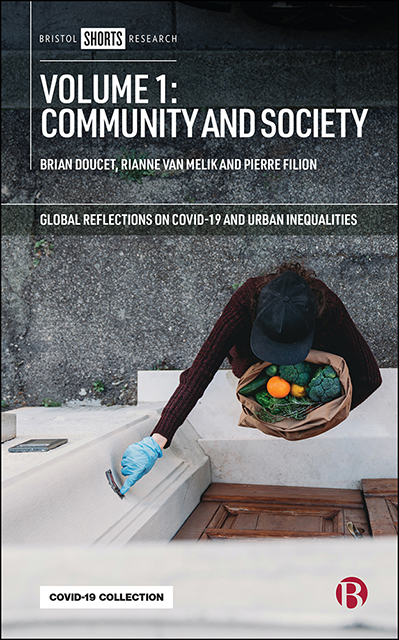Book contents
- Frontmatter
- Contents
- List of Figures and Tables
- Notes on Contributors
- Acknowledgments
- Preface to All Four Volumes of Global Reflections on COVID-19 and Urban Inequalities
- One Introduction
- Part I Working Practices
- Part II Life During Lockdown
- Part III Migration, Migrants, and Refugees
- Part IV Age, Race, Gender, and Ability
- Index
Fifteen - The COVID-19 Pandemic and the Travails of Rohingya Refugees in the Largest Bangladeshi Refugee Camp
Published online by Cambridge University Press: 13 April 2023
- Frontmatter
- Contents
- List of Figures and Tables
- Notes on Contributors
- Acknowledgments
- Preface to All Four Volumes of Global Reflections on COVID-19 and Urban Inequalities
- One Introduction
- Part I Working Practices
- Part II Life During Lockdown
- Part III Migration, Migrants, and Refugees
- Part IV Age, Race, Gender, and Ability
- Index
Summary
Introduction
COVID-19 has been labeled a ‘pandemic’, which turned out to be one of the most terrifying diseases causing an impending crisis the world has not witnessed in the recent era (Chattoraj, 2021). Before the development of successful vaccines, the World Health Organization's (WHO) recommendations such as quarantining, wearing masks, self-isolating, maintaining social distance, and lockdown were the only measures available to combat COVID-19 (Ullah et al, 2021). However, these are not always feasible for all communities (see Lemanski and de Groot, Chapter Ten); for the refugees living in small and overcrowded tiny shacks that are found in refugee camps, a major challenge lies in maintaining social distance and lockdown measures. Rohingya refugees in Bangladesh, who were forced out of the Northern Rakhine State of Myanmar in the face of brutal persecution, rapes, and killings are no exception (Ullah and Chattoraj, 2018).
There are an estimated 1.2 million Rohingya refugees staying in 34 camps (Bhuyian, 2021) outside Cox's Bazar, a district of southeast Bangladesh (Ullah and Chattoraj, 2021). They face a heightened risk of COVID-19 owing to poor, cramped conditions and densely populated camps. They lack access to adequate health care, shelter, water, and sanitation, which pose major challenges in their efforts to protect themselves from the virus. Therefore, the main objective of this chapter is to provide details about these challenges, and the experiences of the Rohingyas in these refugee camps due to the sudden emergence of the pandemic.
During the initial phases of the outbreak, health experts from the United Nations High Commissioner for Refugees (UNHCR) and International Organization for Migration (IOM) warned that if the virus reached the world's largest refugee camp, it would spread like wildfire and Bangladesh might become devastated by COVID-19 due to the arrangements of camp settlements. The population density in the Rohingya camp is more than 100,000 people per square mile and sanitation options are scarce. Groceries, kiosks, health centers, and schools are all located within the camps, making congestion worse (Ullah et al, 2020). These camps are overcrowded as many families have more than ten members living in one room. Severely substandard health care and inadequate access to proper sanitation have made them incredibly vulnerable to this virus.
The context
The virus first hit the Rohingya camp in Bangladesh in March 2020. By April, 2021, around 507 Rohingyas had tested positive, eleven of whom had died (Sakib, 2021).
- Type
- Chapter
- Information
- Volume 1: Community and Society , pp. 165 - 174Publisher: Bristol University PressPrint publication year: 2021



